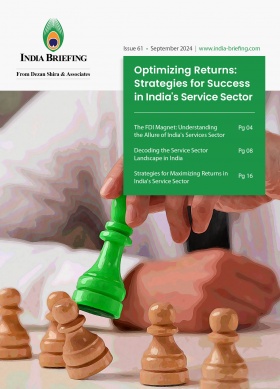Strategies for Maximizing Returns in India’s Service Sector
We discuss how key strategies can help companies in India’s services sector enhance branding, boost loyalty, retain talent, drive innovation meet ESG goals, strengthen stakeholder relationships, and ensure long-term success in a dynamic global marketplace.
As India continues to develop, the services sector presents immense opportunities for investors and businesses alike. In this chapter, we discuss some of the strategies that can be employed to maximize returns in this dynamic environment.
Leveraging digital transformation
Digital transformation is revolutionizing the services sector, offering unprecedented opportunities for growth and innovation. Businesses can harness the power of technology to enhance efficiency, customer experience, and scalability.
Key areas to focus on include:
- Cloud computing and AI: Implementing cloud solutions and AI-driven analytics can streamline operations, reduce costs, and provide deeper insights into consumer behavior. Cloud computing allows for scalable and flexible IT infrastructure, enabling businesses to handle large volumes of data efficiently. AI, on the other hand, can automate routine tasks, predict market trends, personalize customer interactions, and optimize decision-making processes.
- Fintech innovations: With a growing digital economy, fintech solutions such as mobile payments, digital wallets, and blockchain can enhance transaction efficiency and security. Mobile payment systems and digital wallets offer convenience and speed, fostering a cashless economy. Blockchain technology ensures transparent and secure transactions, reducing fraud and enhancing trust. Fintech innovations also enable businesses to offer new financial services, reaching a broader customer base and improving financial inclusion.
- E-commerce and online platforms: Investing in e-commerce platforms can tap into the expanding online consumer base, driven by increasing internet penetration and smartphone usage. Robust e-commerce infrastructure allows businesses to offer a seamless shopping experience, from product discovery to delivery. Online platforms can also facilitate better customer engagement through personalized recommendations, reviews, and customer service. Additionally, leveraging data from e-commerce activities can provide valuable insights into consumer preferences and market trends, enabling businesses to tailor their offerings and marketing strategies effectively.
Focus on skill development and talent management
The services sector is highly dependent on human capital. Investing in skill development and effective talent management can lead to a more productive and innovative workforce. Strategies include:
- Training programs: Regular training and upskilling programs can keep employees updated with the latest industry trends and technologies. Continuous learning opportunities, such as workshops, certifications, and online courses, help employees enhance their skills and adapt to changing market demands. Additionally, mentorship programs and cross-functional training can promote knowledge sharing and foster a culture of continuous improvement.
- Attractive compensation packages: Offering competitive salaries and benefits can attract and retain top talent. Comprehensive compensation packages that include performance bonuses, health benefits, retirement plans, and other perks can make a company more appealing to potential employees. Additionally, aligning compensation with industry standards and recognizing individual and team achievements can motivate employees and reduce turnover rates.
- Employee engagement: Cultivating a positive work environment and engaging employees through recognition and growth opportunities can boost morale and productivity. Creating a culture of open communication, where employees feel heard and valued, is essential. Providing opportunities for career advancement, professional development, and leadership roles can inspire loyalty and commitment. Implementing employee recognition programs, team-building activities, and wellness initiatives can further enhance job satisfaction and foster a sense of belonging.
- Work-life balance: Supporting a healthy work-life balance is crucial for employee well-being and retention. Offering flexible work arrangements, such as remote work options and flexible hours, can help employees manage their personal and professional lives more effectively. Encouraging regular breaks and time off can prevent burnout and maintain high levels of performance.
- Diversity and inclusion: Promoting diversity and inclusion within the workforce can lead to a more dynamic and innovative environment. Diverse teams bring different perspectives and ideas, enhancing problem-solving and decision-making processes. Implementing policies that support diversity, equity, and inclusion can attract a wider talent pool and create a more inclusive workplace culture.
Enhancing customer experience
Exceptional customer service can be a significant differentiator in the services sector. Companies should focus on:
- Personalization: Utilizing data analytics to offer personalized services can enhance customer satisfaction and loyalty. By analyzing customer data, businesses can gain insights into individual preferences, behaviors, and purchase history. This enables them to tailor their offerings, recommendations, and communication to meet specific customer needs. Personalization can extend to various touchpoints, such as personalized marketing messages, customized product recommendations, and tailored customer support, creating a more engaging and relevant experience for each customer.
- Omni-channel approach: Providing seamless service across multiple channels (online, mobile, in-store) ensures a consistent customer experience. An omni-channel strategy allows customers to interact with a brand through their preferred channels while maintaining continuity in their experience. For example, a customer might start their shopping journey on a mobile app, continue browsing on a desktop, and complete the purchase in-store. Ensuring that information, such as shopping cart contents and customer support interactions, is synchronized across all channels can create a cohesive and convenient experience, enhancing customer satisfaction and loyalty.
- Feedback mechanisms: Implementing robust feedback systems can help in understanding customer needs and improving service quality. Encouraging customers to provide feedback through surveys, reviews, social media, and direct communication can offer valuable insights into their experiences and expectations. Analyzing this feedback can identify areas for improvement and inform decision-making processes. Additionally, responding to feedback promptly and addressing any concerns or issues can demonstrate a company’s commitment to customer satisfaction and build trust.
- Customer support: Providing exceptional customer support is critical in enhancing the overall customer experience. Investing in training for customer service representatives, utilizing AI powered chatbots for quick responses, and offering 24/7 support can ensure that customers receive timely and effective assistance. Proactive customer support, such as reaching out to customers to resolve potential issues before they escalate, can further enhance satisfaction and loyalty.
- Loyalty programs: Implementing loyalty programs can reward repeat customers and encourage continued engagement with the brand. Offering incentives such as discounts, exclusive offers, and rewards points can motivate customers to return and make additional purchases. Personalized loyalty programs that cater to individual preferences and behaviors can further enhance the perceived value and strengthen customer relationships.
- User-friendly interfaces: Ensuring that digital interfaces, such as websites and mobile apps, are user-friendly and intuitive can significantly impact the customer experience. Streamlined navigation, quick loading times, and clear information can make it easier for customers to find what they need and complete their desired actions. Regularly updating and optimizing digital interfaces based on user feedback and technological advancements can maintain a high standard of usability.
Strategic partnerships and collaborations
Collaborating with other businesses can lead to mutual benefits and expanded market reach. Key approaches include:
- Joint ventures: Partnering with local or international firms can provide access to new markets and shared resources. Joint ventures allow companies to combine their strengths and expertise, leveraging each other’s market knowledge, technology, and distribution channels. This collaboration can reduce entry barriers in foreign markets, mitigate risks, and accelerate growth. By sharing resources and costs, joint ventures can also lead to innovative product development and enhanced competitiveness.
- Public-private partnerships (PPPs): Collaborating with government entities can unlock opportunities in sectors like healthcare, education, and infrastructure. PPPs can provide access to public funding, regulatory support, and large-scale projects that may be challenging for private companies to undertake alone. These partnerships can drive significant social and economic impact, improving public services and infrastructure while generating business opportunities. Companies can benefit from the credibility and stability associated with government collaboration, attracting further investment and community support.
- Industry alliances: Joining industry associations and networks can facilitate knowledge sharing and innovation. Industry alliances bring together companies with common interests to address shared challenges, advocate for favorable policies, and promote best practices. Participation in these networks can provide access to valuable insights, research, and development opportunities. Collaborative efforts within industry alliances can lead to the creation of standards, fostering interoperability and enhancing the overall industry’s growth and sustainability.
- Supplier and vendor partnerships: Establishing strong relationships with suppliers and vendors can enhance the efficiency and reliability of supply chains. Collaborative partnerships can lead to better terms, improved quality control, and innovation in product development. By working closely with suppliers, companies can ensure a steady flow of materials and components, reduce costs, and respond more effectively to market demands and disruptions.
- Academic and research collaborations: Partnering with academic institutions and research organizations can drive innovation and access to cutting-edge technology. Collaborative research projects can lead to the development of new products, services, and processes. Companies can leverage academic expertise and facilities for research and development, gaining a competitive edge in their respective industries. Additionally, these partnerships can provide access to a pool of skilled graduates and potential future employees.
- Technology and innovation hubs: Collaborating with technology and innovation hubs, such as incubators and accelerators, can support startup growth and foster a culture of innovation. These hubs provide access to resources, mentorship, and networking opportunities that can accelerate the development and commercialization of new technologies. Companies can benefit from the dynamic ecosystem of startups and innovators, gaining insights into emerging trends and potential investment opportunities.
- Cross-sector collaborations: Engaging in cross-sector collaborations can lead to the development of holistic solutions to complex challenges. For example, collaborations between technology firms, healthcare providers, and insurance companies can result in integrated health solutions that improve patient outcomes and reduce costs. Cross-sector partnerships can drive systemic change and create value that extends beyond individual sectors.
Adapting to regulatory changes
The regulatory landscape in India is continually evolving. Staying compliant and adapting to changes promptly can prevent disruptions and open new avenues for growth. Strategies include:
- Regular compliance audits: Conducting periodic audits to ensure adherence to regulatory standards. Regular compliance audits help identify potential non-compliance issues before they become problematic. These audits should cover all aspects of the business, including financial reporting, environmental regulations, labor laws, and industry-specific requirements. Implementing robust internal controls and maintaining thorough documentation can facilitate smoother audits and quick rectification of any discrepancies.
- Proactive engagement: Engaging with regulatory bodies to stay informed about upcoming changes and participating in policy discussions. Building relationships with regulatory authorities and industry associations can provide valuable insights into the regulatory landscape. Proactive engagement allows businesses to anticipate changes and prepare accordingly. Participation in public consultations and industry forums can also enable companies to voice their concerns and influence policy decisions, ensuring that new regulations are practical and supportive of industry growth.
- Legal expertise: Having a dedicated legal team or consultancy to navigate complex regulatory frameworks. A skilled legal team can provide guidance on compliance issues, interpret new regulations, and represent the company in discussions with regulators. Legal experts can also help develop strategies to minimize regulatory risks and ensure that business operations align with current laws. For smaller businesses, partnering with specialized consultancy firms can be a cost-effective way to access the necessary expertise and stay compliant.
- Regulatory technology (RegTech): Leveraging RegTech solutions can enhance compliance and are encouraged to report potential issues, can significantly reduce risks.
- Scenario planning and risk management: Developing scenario plans to prepare for potential regulatory changes. Businesses can conduct impact assessments to understand how new regulations might affect operations and devise contingency plans. Implementing a risk management framework that includes regular monitoring of regulatory developments and proactive risk mitigation strategies can help companies adapt quickly and minimize disruptions.
- Collaborative industry efforts: Work with other businesses and industry bodies to address common regulatory challenges. Collaborative efforts can include joint lobbying for favorable policies, sharing best practices for compliance, and developing industry standards. By presenting a united front, businesses can have a stronger influence on regulatory changes and create a more supportive environment for industry growth.
Expanding into emerging markets
India’s tier 2 and tier 3 cities present untapped potential for the services sector. Strategies for expansion include:
- Market research: Conducting thorough market research to understand local needs and preferences is essential. Emerging markets often have unique characteristics and consumer behaviors that differ from metropolitan areas. Market research helps identify market size, consumer demographics, purchasing power, and competitors. Insights gained from research enable businesses to tailor their strategies and offerings effectively, ensuring relevance and resonance with the local population.
- Localization: Tailoring services to meet the specific demands of these markets is crucial for success. Localization involves adapting products, services, marketing strategies, and customer support to align with cultural preferences, language differences, and regional nuances. This approach builds trust and enhances customer satisfaction by demonstrating a commitment to understanding and meeting local needs. Localization efforts may include offering regional language support, incorporating local flavors or customs into services, and adjusting pricing strategies to reflect local economic conditions.
- Affordable offerings: Developing cost-effective solutions to cater to the price-sensitive consumer base in emerging markets is essential. Tier 2 and tier 3 cities often have lower average incomes compared to metropolitan areas, making affordability a key consideration for consumer decision-making. Businesses can achieve affordability through efficient operational processes, economies of scale, and strategic partnerships with local suppliers. Pricing strategies should be competitive yet profitable, striking a balance between affordability and value perception to attract and retain customers.
- Infrastructure investment: Investing in local infrastructure to support service delivery and operations is crucial for expanding into emerging markets. Infrastructure improvements may include establishing distribution networks, logistics hubs, and customer service centers in strategic locations. Reliable infrastructure enhances operational efficiency, reduces costs, and improves service reliability, contributing to customer satisfaction and loyalty.
- Digital and mobile accessibility: Mobile penetration rates are high in tier 2 and tier 3 cities, presenting opportunities for businesses to engage with consumers through mobile apps, digital platforms, and social media channels. Digital initiatives such as mobile payments, e-commerce platforms, and online customer support can enhance convenience and accessibility, expanding market reach and driving growth.
- Partnerships and alliances: Forming strategic partnerships and alliances with local businesses, distributors, and community organizations can facilitate market entry and accelerate growth in emerging markets. Partnerships provide access to local expertise, networks, and customer bases, reducing entry barriers and enhancing market penetration. Collaborating with trusted local partners can also mitigate risks associated with cultural, regulatory, and operational challenges, fostering long-term success in new markets.
Sustainability practices
Sustainability is becoming increasingly important for consumers and investors alike. Adopting sustainable practices not only aligns businesses with global environmental goals but also enhances brand reputation and long-term profitability.
Key strategies include:
- Greening operations: Implementing green technologies and practices to reduce environmental impact is fundamental. This includes initiatives such as energy-efficient operations, waste reduction and recycling programs, and adopting renewable energy sources. Businesses can invest in technologies that minimize carbon emissions, optimize resource usage, and promote sustainability throughout their operations. By reducing their ecological footprint, companies demonstrate their commitment to environmental stewardship and attract environmentally conscious consumers.
- Corporate social responsibility (CSR): Engaging in CSR activities that contribute to social and environmental well-being is essential. CSR initiatives may include community development projects, philanthropy, and educational programs that address local needs and support sustainable development goals. Businesses can align CSR efforts with their core values and business objectives, fostering positive relationships with stakeholders and enhancing brand loyalty. Transparent communication about CSR activities builds trust and credibility, reinforcing the company’s commitment to ethical practices and social responsibility.
- Sustainable supply chain: Ensuring that the supply chain adheres to sustainable practices is critical for comprehensive sustainability efforts. Businesses can collaborate with suppliers to promote ethical sourcing practices, reduce carbon emissions in transportation and logistics, and minimize waste throughout the supply chain. Implementing sustainability criteria in supplier selection, conducting audits, and setting clear sustainability goals can drive continuous improvement and resilience in the supply chain. By prioritizing sustainability across the supply chain, companies mitigate risks, enhance efficiency, and meet growing consumer demand for responsibly sourced products and services.
- Innovation and research: Investing in innovation and research to develop sustainable products, services, and business models is key to long term sustainability. Businesses can integrate sustainability considerations into product design, incorporating recycled materials, biodegradable packaging, and energy-efficient features. Research initiatives can explore new technologies and practices that advance sustainability goals, driving industry innovation and setting new standards for environmental performance. By leading in sustainable innovation, companies can differentiate themselves in the market, attract eco-conscious consumers, and gain a competitive edge.
- Regulatory compliance and standards: Staying abreast of regulatory requirements and industry standards related to sustainability and ESG is essential for maintaining compliance and credibility. Businesses should monitor evolving regulations, participate in industry discussions, and proactively adapt their practices to meet or exceed environmental regulations. Compliance with sustainability standards, certifications, and reporting frameworks demonstrates accountability and ensures transparency in corporate sustainability efforts.
Conclusion
Maximizing returns in India’s service sector requires a multifaceted approach, integrating technology, talent, customer-centric strategies, and sustainable practices. By leveraging these strategies, businesses can not only achieve robust growth but also contribute to the broader economic development of the country. The dynamic nature of the sector calls for continuous innovation and adaptability, making it an exciting and rewarding domain for investors and entrepreneurs.
About Us
India Briefing is one of five regional publications under the Asia Briefing brand. It is supported by Dezan Shira & Associates, a pan-Asia, multi-disciplinary professional services firm that assists foreign investors throughout Asia, including through offices in Delhi, Mumbai, and Bengaluru in India. Readers may write to india@dezshira.com for support on doing business in India. For a complimentary subscription to India Briefing’s content products, please click here.
Dezan Shira & Associates also maintains offices or has alliance partners assisting foreign investors in China, Hong Kong SAR, Dubai (UAE), Indonesia, Singapore, Vietnam, Philippines, Malaysia, Thailand, Bangladesh, Italy, Germany, the United States, and Australia.
- Previous Article Employee Retention Strategy in India: Corporate Sector Explores New Retirement Options in 2025
- Next Article India-Slovakia Bilateral Economic and Trade Relations








